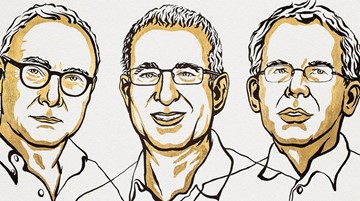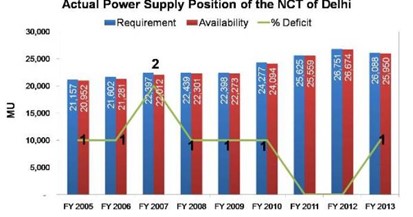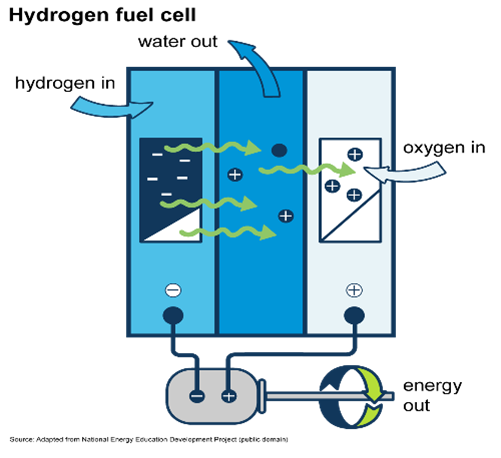Wednesday, 13th October 2021
Global Multidimensional Poverty Index (MPI), 2021
In News
The 2021 global Multidimensional Poverty Index (MPI) was released by the United Nations Development Programme (UNDP) and the Oxford Poverty and Human Development Initiative.
Key Findings of the MPI, 2021

India’s status on the MPI, 2021
- India has 381 million people living in multidimensional poverty
- Five out of six multidimensionally poor people are from lower tribes and castes.
- 65 million of the 129 million people of Scheduled Tribes live in multidimensional poverty.
- 94 million of 283 million people of Scheduled Caste live in multidimensional poverty.
- 160 million of 588 million people of Other Backward Class live in multidimensional poverty.
- 162 million people live in female-headed households.
About the Multi-Dimensional Index
- The global Multidimensional Poverty Index (MPI) is an international measure of acute multidimensional poverty covering over 100 developing countries.
- It complements traditional monetary poverty measures by capturing the acute deprivations in health, education, and living standards that a person faces simultaneously.
- The MPI assesses poverty at the individual level. If a person is deprived in a third or more of ten (weighted) indicators, the global MPI identifies them as ‘MPI poor’.
- The extent – or intensity – of their poverty is also measured through the percentage of deprivations they are experiencing.
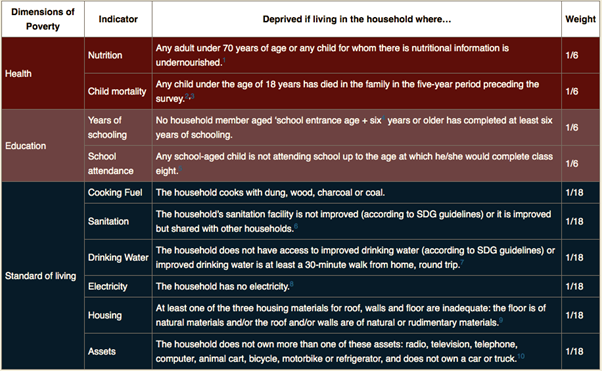
Sources:
Global Methane Pledge - Edukemy Current Affairs
In News
Twenty-four more countries have joined a US and EU-led effort to slash methane emissions 30 per cent by 2030 from the 2020 levels.
About The News
- Global Methane Pledge, was first announced by the United States and EU in September with the aim to galvanise rapid climate action before the start of the Glasgow COP26.
- The nine original partners include Britain, Indonesia and Mexico, which signed on to the pledge when it was announced at the Major Economies Forum last month. The partnership will now cover 60 per cent of the global GDP and 30 per cent of global methane emissions.
- It can have a significant impact on the energy, agriculture and waste sectors responsible for the bulk of methane emissions.
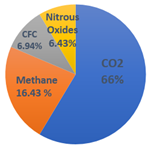
Methane and Global Warming
- Potent GHG: Methane is a potent greenhouse gas and, according to the latest IPCC Report accounts for about half of the 1.0 degree Celsius net rise in global average temperature since the pre-industrial era.
- Methane is a major constituent of natural gas, but its chemical and physical characteristics also make it a powerful greenhouse gas.
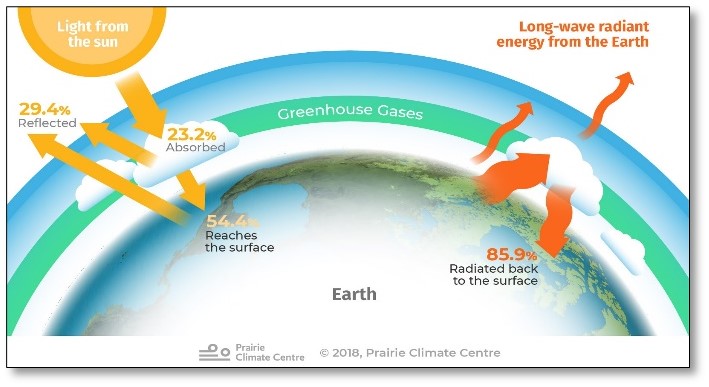
- Heat Retention capacity: Methane retains heat in the atmosphere like carbon dioxide, which makes it a very dangerous greenhouse gas. However, the fear is that it will be warming, with 28 times the potential of carbon dioxide (CO2).
- Long lasting impact: The half-life of methane in the atmosphere is quite short. The influence of methane lasts a very short time, but its impact is significant, with a predicted half-life of 9.1 years in the atmosphere.
- Recent Growth: According to the Environmental Protection Agency (EPA), the amount of methane in the atmosphere has multiplied since the industrial revolution, growing from an estimated 722 parts per billion (ppb) in 1750 to 1834 ppb in 2015.
- Contributors of Methane: Energy, Agriculture and Waste sectors are responsible for the bulk of methane emissions.
- Fossil Fuels: Methane is not released when we burn fossil fuels, as carbon dioxide does, but rather during the extraction, processing, and distribution of fossil fuels.
- Agriculture: Cattle and production of rice is the second-largest source of methane. Rice paddies contain methane-producing microorganisms as well, and the soggy fields release about 1.5% of global methane emissions.
- Depleting Ice-Cover: As Arctic and Antarctic regions warm up quickly methane is released even in the absence of direct human activity.
Sources:
Guidelines for Cybersecurity in Power Sector
In News
The Government has released guidelines for cybersecurity in the power sector for the first time, to create a secure cyber ecosystem.
About the News
- Prepared by: The Central Electricity Authority (CEA) under the provision of Section 3(10) of the Central Electricity Authority (Technical Standards for Connectivity to the Grid) (Amendment) Regulations, 2019 has framed the guidelines.
- Applicability: The norms are applicable to all responsible entities and system integrators, equipment manufacturers, suppliers/ vendors, service providers, and IT hardware/ software OEMs (original equipment manufacturers) engaged in the Indian power supply system
About the Guidelines
- Cyber Assurance Framework: It lays down a cyber assurance framework, strengthens the regulatory framework, puts in place mechanisms for security threat early warning, vulnerability management and response to security threats, and secures remote operations and services, among others.
- Procurement and Testing before deployment: The guidelines mandate ICT-based procurement from identified 'trusted sources' and 'trusted products' or the product has to be tested for malware/ hardware trojan before deployment for use in the power supply system network.
- Enhance R&D: It will promote research and development in cybersecurity and open up the market for setting up cyber testing infra in public and private sectors in the country.
Recent Development in Cyber Security
- Need: Cybersecurity measures need to be strengthened, given that the power sector has been deploying emerging technologies in its core operations.
- Revamped Distribution Sector Scheme: In August, the government approved the Revamped Distribution Sector Scheme to improve all power distributions companies and department (DISCOMs) operations by boosting the supply infrastructure using artificial intelligence (AI)-based solutions.
- With the help of AI, the government aims to analyse data generated through IT/OT devices such as system metres, demand forecasting, Time of Day (ToD) tariff, renewable energy (RE) integration, and other predictive analyses.
- Also, for prepaid smart metres to prepare system-generated energy accounting reports every month, enabling DISCOMs to make informed decisions on loss reduction.
- Funds under the scheme would also be used for the development of AI-driven applications. The government expects this to promote the development of start-ups in the distribution sector across the country
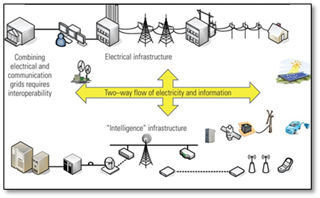
Sources:
- Govt releases guidelines for cybersecurity in power sector
- Indian Government Releases Cybersecurity Guidelines for Power Sector
Image Sources:
India’s Nuclear Doctrine
In News
A.Q. Khan, a scientist known as the father of Pakistan’s clandestine nuclear programme, passed away recently after a brief illness.
About the News
- The nuclear physicist faced criticism in 2004 when he was forced to accept responsibility for nuclear technology proliferation and was forced to live a life of official house arrest.
- Khan, born in Bhopal in 1936, and whose family migrated to Pakistan during Partition, was seen as a patriot, the victim of an international conspiracy to rob Pakistan of its nuclear jewels, and to defame the country.
- The origins and evolution of Khan’s network were tied to the domestic and international political motivations underlying Pakistan's nuclear weapons project.
- In 1998, India detonated a total of five devices in nuclear tests on May 11 and 13. Pakistan responded with six nuclear tests in May. In the years following the multiple nuclear tests in the Indian subcontinent, a massive global nuclear proliferation scandal came to light.
What is a Nuclear Doctrine?
- Nuclear doctrine encompasses the goals and missions that guide the deployment and use of nuclear weapons that determine each Nuclear Weapon States’ (NWS) force structure, declaratory policy and diplomacy.
- A nuclear doctrine states how a nuclear weapon state would employ its nuclear weapons both during peace and war. By communicating to the enemy its stated intentions and resolve, nuclear doctrines help states to establish deterrence vis-à-vis its adversary during peace and once deterrence fails, guides the state’s response during war.
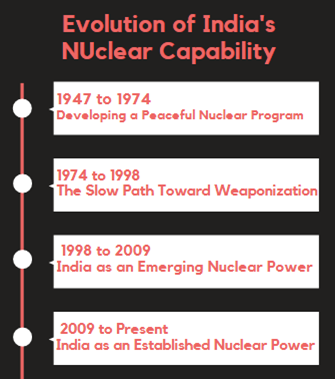
India’s Nuclear Doctrine
- Building and maintaining a credible minimum deterrent;
- A posture of "No First Use" nuclear weapons will only be used in retaliation against a nuclear attack on Indian territory or on Indian forces anywhere;
- Nuclear retaliation to a first strike will be massive and designed to inflict unacceptable damage.
- Nuclear retaliatory attacks can only be authorised by the civilian political leadership through the Nuclear Command Authority.
- Non-use of nuclear weapons against non-nuclear weapon states;
- However, in the event of a major attack against India, or Indian forces anywhere, by biological or chemical weapons, India will retain the option of retaliating with nuclear weapons;
- A continuance of strict controls on export of nuclear and missile related materials and technologies, participation in the Fissile Material Cutoff Treaty negotiations, and continued observance of the moratorium on nuclear tests.
- Continued commitment to the goal of a nuclear weapon free world, through global, verifiable and non-discriminatory nuclear disarmament.
India’s status w.r.t. global nuclear agreements
- NSG & MTCR: India is actively pursuing membership to the Nuclear Suppliers Group (NSG) and became a member of the Missile Technology Control Regime in 2016.
- NPT and CTBT: India remains outside both the Treaty on the Non-Proliferation of Nuclear Weapons (NPT) and the Comprehensive Nuclear Test Ban Treaty (CTBT).
- Facility-specific safeguard: India has a facility-specific safeguards agreement in place with the International Atomic Energy Agency (IAEA) and a waiver from the Nuclear Suppliers Group (NSG) allowing it to participate in global civilian nuclear technology commerce.
- TPNW: As far as the Treaty on the Prohibition of Nuclear Weapons (TPNW) is concerned, India did not participate in the negotiations on the TPNW and has consistently made it clear that it will not become a party to the Treaty.
- Conference on Disarmament: India attaches high importance to the Conference on Disarmament as the world’s single multilateral disarmament negotiating forum
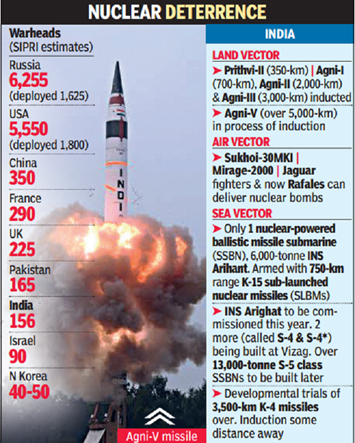
What are the problems with India’s Nuclear Doctrine?
- No First Use Policy: Analysts argue that NFU posture is only possible for a country that has “extreme confidence not only in the survivability of its national nuclear forces sufficient to muster a devastating retaliatory strike, but also in the efficacy of its crisis management system.
- They argue that crisis management is not India’s forte. The Indian bureaucratic system is manifestly incapable of handling any emergency as dire as a nuclear strike.
- NFU is more a peacetime declaration that a country does not have to abide by during war.
- Also, it frees Pakistan from fearing an Indian nuclear riposte to either terrorism or limited war.
- Credible minimum deterrence (CMD): Many analysts see deterrence as a matter of delicate balance that needs constant care. India needs intercontinental ballistic missiles (ICBMs) to underpin its doctrine of minimum but credible deterrence. Relying on long-range bombers, is antithetical to a credible deterrence posture.
- India needs to keep the idea of CMD open-ended, saying that “with a policy of No First Use and Massive Retaliation, the concept of CMD must factor in ‘survivability and sufficient numbers’ that can inflict unacceptable damage.
- Nuclear deterrence of CBW use: The Indian nuclear doctrine leaves Indian decision makers the option of using nuclear weapons to retaliate against Chemical or biological warfare (CBW) use. CBW are anyways outlawed, and if non-state actors use these weapons, then India’s nuclear deterrent could in any way not be effective because it is not designed to counter such actors.
- Command-and-control issues: The deficiencies of the command-and-control arrangements are yet another indicator of the weaknesses of India’s nuclear doctrine. Military doctrines are, after all, about how military forces are to be used in war. India’s nuclear operational capacity is doubtful because the Indian nuclear doctrine leaves the military out of the decision making loop.
- Massive retaliation: Most analysts fear the threat to be empty. Some argue that India should consider substituting “punitive” for “massive” in the doctrine.
- There is also lack of compatibility between massive retaliation and minimum deterrence, as small nuclear force cannot produce massive attacks.
- Terrorism and Tactical nuclear weapons (TNWs): Though issues such as terrorism and TNWs were not mentioned in the Indian nuclear doctrine, the doctrine’s capacity to deal with these challenges has become a contentious issue. Pakistan’s use of terrorism can be countered by India also developing similar capabilities, rather than having to escalate to the nuclear level.
Conclusion:
There is a near consensus in the Indian strategic community that India’s nuclear doctrine needs to be periodically re-examined. There is also a consensus that the Indian government needs to release more information about its nuclear doctrine and policy, both in order to deter adversaries and so that Indian public debate is better informed.
Traditionally, India’s nuclear arsenal focused on deterring Pakistan, but India’s nuclear posture may begin to take China into account. This may lead to a shift in India’s view regarding the role its arsenal plays against Pakistan. The force requirements needed in order to threaten assured retaliation against China may allow India to pursue more aggressive strategies, with the potential for a first strike against Pakistan
Question: Discuss India’s Nuclear Doctrine and the problems associated with it.
Sources:
- Abdul Qadeer Khan, father of Pakistan’s nuclear programme, passes away
- GLOBAL ENTERPRISE TO STRENGTHEN NONPROLIFERATION AND DISARMAMENT
- CABINET COMMITTEE ON SECURITY REVIEWS PROGRESS IN OPERATIONALIZING INDIA’S NUCLEAR DOCTRINE
- India behind China and Pakistan in nuclear-warheads but not worried
- India's view on the Treaty on the Prohibition of Nuclear Weapons
- India’s Nuclear Doctrine Debate
This Day in History - International Day for Disaster Risk Reduction
On October 13, 1989, the International Day for Disaster Risk Reduction was started, after a call by the United Nations General Assembly for a day to promote a global culture of risk-awareness and disaster reduction. The 2021 edition focuses on “International cooperation for developing countries to reduce their disaster risk and disaster losses.” This is the sixth of the Sendai Seven targets. In 2015 at the Third UN World Conference on Disaster Risk Reduction in Sendai, Japan, the Sendai Framework for Disaster Risk Reduction came into force. It is people-focussed and action-oriented in its approach to disaster risk reduction and applies to the risk of small-scale and large-scale disasters caused by man-made, or natural hazards, as well as related environmental, technological and biological hazards and risks. The year 2021 promises to be a make-or-break year when it comes to delivering on the policy agenda agreed in 2015. Without real action on climate in the next ten years, extreme weather events will be overwhelming, especially for developing countries.
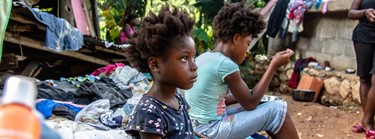
Source:
Image of the Day - Tropical Cyclone Kompasu
This is image of rescue operations being carried out in Philippines, as Cyclone Kompasu made landfall in Philippines. The Philippines, an archipelago of more than 7,600 islands is hit by about 20 storms or typhoons annually, bringing heavy rains that trigger deadly landslides. They may occur any time of the year with August being the most active month. According to some estimates, the Philippines is the most exposed country in the world to tropical storms or typhoons. A typhoon is a mature tropical cyclone that develops between 180° and 100°E in the Northern Hemisphere. In the Philippine languages, tropical cyclones are generally called bagyo. Kompasu is the 13th tropical storm to enter the Philippines this year. As per Skymet Weather Services, Typhoon Kompasu may travel across Philippines, Hainan, Vietnam, Laos and Thailand over the next 4 days. The remnants of the typhoon are likely to reach Bay of Bengal, cutting across Myanmar around October 16-17.
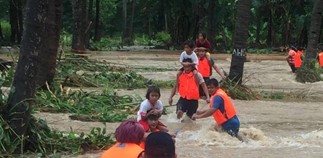
Sources:
Freight Train 'Trishul'
- Context: Indian Railways has operated one of longest freight trains recently.
- The train has been named “Trishul" to indicate three trains being operated as a single train which consisted of 176 wagons and operated at an average speed of 50 Kmph from Vijayawada to Duvvada in the South Central Railway zone.
- The initiative was taken to speed up the operation of goods trains so that the empty wagons can be transported to their loading point in the least possible time.
- Such Initiatives:
- Help in meeting the demands of the customer expeditiously. For example, meeting the demand of the power houses for Coal.
- Help in reducing the wagon turnaround time (the average time taken by a wagon from the time it is loaded till it secures its next load.)
- Reduces the manpower need
- Enhances the operational efficiency of the train movement
- Helps in utilizing the rolling stock optimally and in transporting the bulk commodities in short timeframe.
- Improves the overall freight performance of the Zone

Source:
- Indian Railways' one of longest freight train 'Trishul' sets new record
- Indian Railways' one of longest freight train 'Trishul' sets new record
Image Source:
Wastage, Efficiency rating
- Context: The environment ministry has notified regulations for water purification systems
- The new 'Regulation on Use of Water Purification System (WPS)' mandate that each water purifier will now come with a 'conformance label' which is a star rating like label declaring its efficiency level as well as water rejection/wastage levels.
- This means that manufacturers of reverse osmosis-based water purifiers will now have to rate their appliances on efficiency and water wastage and water supply agencies will have to declare the total dissolved solids (TDS) in the water being supplied.
- The RO manufacturer now has to obtain standard mark/certification under a licence from the BIS on the water purification system.
- At present, purification machines have around 20% water recover efficiency as they are estimated to reject/waste near 70-80% of the water taken in for purification.
- The water recover efficiency is now being aimed at 40-60% to reduce wastage.

Source:
- Water purifiers must mention wastage, efficiency rating: Officials
- Wastages and efficiency ratings must be mentioned by water purifiers: Officials
Image Source:
Kit for Rapid Silicosis Test
- Context: Scientists in a Mumbai-based laboratory have developed a rapid test kit to detect Silicosis.
- Silicosis is a progressive, long-term lung disease caused by the prolonged exposure and inhalation of large amounts of crystalline silica dust.
- The test is called as the point of care test and the kit is similar to a pregnancy test kit and it identifies the levels of serum CC16 in a drop of blood.
- Based on the concentration of the serum, the patient can be diagnosed with severe, mild disease or whether he/she is likely to develop it in the near future.
- In cases of early silicosis, the value of serum CC16 will be between 6 and 9 ng/ml.
- It has been developed by the Mumbai team of the National Institute of Virology (NIV) in collaboration with the National Institute for Occupational Health.
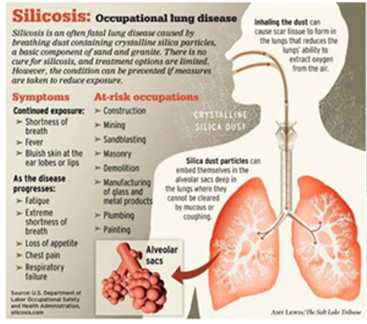
Sources:
- Experts build kit for rapid silicosis test
- Mumbai: Scientists Develop World's First Rapid Test Kit to Detect Silicosis
Image Sources:
Surrogate advertising
- Context: A famous celebrity recently terminated his contract with Pan Masala brand as it fell under Surrogate advertising.
- Surrogate advertising is a form of advertising which is used to promote regulated products, like cigarettes and alcohol, in the disguise of another product.
- The surrogate or substitute could either resemble the original product or could be a different product altogether but it is marketed under the established brand name of the original product such as club soda, mineral water in case of alcohol, or products of a completely different category (like music CD's or playing cards).
- This is done to hammer the brand name into the heads of the consumers.
- These advertisements are used to promote and advertise products of brands when the original product cannot be advertised on mass media.
Sources:
- Amitabh Bachchan Terminates Contract with paan Masala Brand: "Wasn't Aware It Falls under Surrogate Advertising"
- India: Surrogate Advertisements in India
Image Source:
The Data Protection Authority can lay the foundation for a solid digital economy: HT
Essence: Data Protection Authority (DPA), proposed under the Personal Data Protection Bill, 2019 ,in the current form has monopoly of the central government as the Selection Committee which recommends appointments to DPA lack representation from judiciary and opposition. The bill delegates powers to DPA so that the regulations are in pace with technological innovation but the power of the central government to issue binding directions might erode its independence. The Bill in the current form entrusts DPA with routine functions which might be overburdened. The reconstituted Joint Parliamentary Committee must look at these issues and lay the foundation of a robust DPA that is competent and independent and predictable in its rulemaking.
Why you should read this article?
- To know about the status of the Personal Data Protection Bill, 2019.
- To understand the importance of the Data Protection Authority.
- To know the issues with the proposed framework of the Data Protection Authority.
Source:
A Stimulus for Governance: BL
Essence: Since Independence, India has often fallen short of efficient execution of policies which has adversely impacted living conditions of masses. Author bats for professionals, especially bureaucrats, to be given ministerial responsibilities. Argument is built on the assumption that because of their professional expertise and absence of ideological rigidity, they are better suited to execute projects efficiently in diverse country like India.
However, article is cautious enough to point out that in view of growing social-economic challenges, a fine balance between elected representatives and bureaucrats/professionals is the need of the hour.
Why should you read this article?
- To understand importance of professionals being inducted in Council of Minister.
- To appreciate skills sets which professionals brings (and Carrer politicians generally lack) as a Minister.
Source:
Animal husbandry needs greater attention: BK
Essence: As the pattern of global consumption is evolving towards higher share of animal products in diets, maize and protein meal will remain the most important feed commodities. But challenges like- disease outbreaks, sanitary restrictions and trade policies will affect the evolution and dynamics of the world meat market. According to several studies, in India by 2022-23, milk production, protein meal demand will expand as India moves towards compound feed-based livestock production. But such a market will have to be part of ‘Sustainable Animal Agriculture Ecosystem’. For the animal feed manufacturers, there are several challenges which they need to be overcome. Article further mentions solutions like, research to study the market and come up with demand projections, strategy to ensure higher yields per milch animal, ways to promote animal health and nutrition, etc. Apart from this, upgrading skills to keep up with global trends, setting up of adequate processing capacity and investment deserve special attention to attract foreign direct investment.
Why should you read this article?
- To understand recent global consumption trend, India in particular and issues associated.
- To understand what possible steps we can take to tackle the same.
Source:
Agriculture App: An Innovation for a Better Life of Farmers
Background
- AgriBolo, a Rajasthan-based app, was founded by brothers Arvind and Ajeet Godara on April 13, 2016.
- Through its call centre and the AgriBolo app, a firm assists farmers with agricultural input delivery and e-trading services.
Initiative
- The goal is to give end-to-end solutions under one roof, from assisting customers with their agricultural techniques through harvesting and selling their produce.
- Objective is to digitally empower farmers and lessen their distress.
- It also provides with expert advice on how to run a successful farm.
- AgriBolo's 'Agrimart' is a one-stop shop where farmers can buy and sell whatever they need.
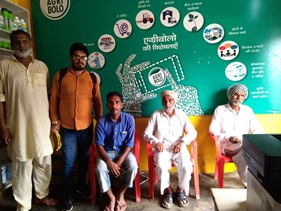
Quote: “If agriculture goes wrong, nothing else will have a chance to go right”
Source:
Share the article
Get Latest Updates on Offers, Event dates, and free Mentorship sessions.

Get in touch with our Expert Academic Counsellors 👋
FAQs
UPSC Daily Current Affairs focuses on learning current events on a daily basis. An aspirant needs to study regular and updated information about current events, news, and relevant topics that are important for UPSC aspirants. It covers national and international affairs, government policies, socio-economic issues, science and technology advancements, and more.
UPSC Daily Current Affairs provides aspirants with a concise and comprehensive overview of the latest happenings and developments across various fields. It helps aspirants stay updated with current affairs and provides them with valuable insights and analysis, which are essential for answering questions in the UPSC examinations. It enhances their knowledge, analytical skills, and ability to connect current affairs with the UPSC syllabus.
UPSC Daily Current Affairs covers a wide range of topics, including politics, economics, science and technology, environment, social issues, governance, international relations, and more. It offers news summaries, in-depth analyses, editorials, opinion pieces, and relevant study materials. It also provides practice questions and quizzes to help aspirants test their understanding of current affairs.
Edukemy's UPSC Daily Current Affairs can be accessed through:
- UPSC Daily Current Affairs can be accessed through Current Affairs tab at the top of the Main Page of Edukemy.
- Edukemy Mobile app: The Daily Current Affairs can also be access through Edukemy Mobile App.
- Social media: Follow Edukemy’s official social media accounts or pages that provide UPSC Daily Current Affairs updates, including Facebook, Twitter, or Telegram channels.

